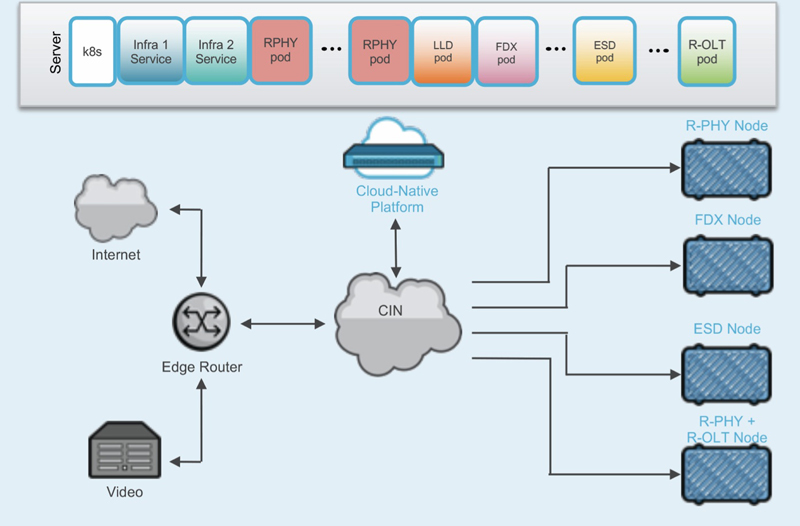10G Technology Network Virtualization
By Asaf Matatyaou
The cable industry is in a perpetual state of enhancing broadband services with technologies and standards that look beyond today’s ever-demanding speed requirements, anticipating for future growth and consumption. It’s no surprise then that there is a focus on the physical layer that dictates the maximum speeds the broadband pipe can deliver to a service group or a small group of subscribers (approximately 100 to 250). It’s an alphabet soup of tools that are available today or will be available shortly: DAA (distributed access architecture), R-PHY (remote PHY), FMA (flexible MAC architecture), FDX (full duplex DOCSIS), ESD (extended spectrum DOCSIS) and PON (passive optical networking) to name a few. All of these tools have similarities in that they specify the physical layer protocols and connectivity between the headend and the home subscriber.
With so many options available and with different market footprints to address, the opportunity is to provide a single unified platform that flexibly delivers multiple physical layer technologies. Equally important is the ability to elastically turn up service groups, services, subscribers and bandwidth based on demand. Cloud-native virtualization is here to deliver on these opportunities and the promise of the cable industry’s 10G initiative.
10G network transformation
The 10G initiative led by CableLabs is clearly about speed, but it’s not all about speed. Speed is also not only about bandwidth. Let’s state the obvious: 10G technology will deliver speeds of 10 Gbps. Other speed-related aspects include reducing time to deploy a service group, improving prediction and reaction time for operational needs, as well as quickly and granularly addressing scaling demands from very small to very large deployments.
Beyond delivering faster symmetrical speeds, 10G technology addresses reliability, security and latency. Moreover, 10G network transformation needs to be built on top of a platform that can adapt and extend to the unknown for years to come, supporting future service and broadband growth drivers.
Defining cloud-native virtualization
Cloud-native virtualization supports management, control and data plane processing of high performance and mission-critical broadband services. However, it’s important to state that hardware is still required for physical layer processing, such as RF. A cloud-native platform is capable of connecting to a variety of physical layer hardware in the network, such as DOCSIS or PON-based networks, as long as the connectivity between the cloud-native platform and the physical layer hardware (e.g., R-PHY node or remote OLT) is Ethernet/IP-based.
There are four characteristics that define a cloud-native platform delivering on the promise of 10G network transformation. They are containerization, dynamic orchestration, microservices and commercial off-the-shelf (COTS) equipment.
- Containerization: Applications are broken up into manageable and functional components, and then are packaged individually with all their dependencies. Containers are self-contained applications that have separate views of resources such as filesystems and network interfaces, with limits on usage of CPU and memory, and are similar but lighter weight compared with virtual machines, as they share the operating system among the applications. The value is that individual containers can be developed, tested and deployed independently from other containers.
- Dynamic orchestration: Kubernetes (k8s) is an open-source system that automates deployment, scaling and the management of the containerized applications, in comparison with a person manually configuring specific applications with hard-coded server resources (e.g., CPU, memory). Kubernetes schedules each application container across a cluster, or set of servers, in the cloud-native platform. A pod encapsulates an individual application composed of multiple co-located containers that are tightly coupled and share resources. The value is that different types of pods or applications can be turned on by Kubernetes elastically without human interaction.
- Microservices: A continuous delivery of single-purpose services, compared with traditional monolithic software that consists of tightly integrated modules delivered infrequently and have to scale as a single unit. The value is that each microservice may change orthogonally from other microservices, isolated to the scale and scope of updated requirements or performance specifications.
- COTS equipment: Leverage COTS servers and switches and ride the wave of economies of scale without the need to develop or deploy custom hardware. The value is the ability to deploy newer generations of CPUs on COTS servers that improve performance and reduce cost per bit of processing on an almost annual basis.
In practical terms, a cloud-native platform can be deployed on a single server with infrastructure services (i.e., non-application services such as a file system) and a single instance of an application or pod, such as a virtual CMTS (vCMTS). As needed, more vCMTS pods can be deployed on the same server. When the server capacity is exhausted, more servers can be added to the cloud-native platform, expanding the server cluster to multiple servers. Different types of applications or pods can be deployed and scaled on the same cloud-native platform over time, connecting to different access networks (e.g., PON for FTTH) or supporting enhanced services such as low latency DOCSIS (LLD) or low latency Xhaul (LLX). Figure 1 shows a cloud-native platform supporting various pod types and connected to various access networks.

Cloud-native virtualization addresses 10G network transformation
With the ability to deliver on the promise of faster speeds, along with elastic, scalable and flexible deployment of access networks and services, a cloud-native platform is a key enabler to achieving the promise of 10G network transformation.
Let’s look a little deeper at 10G objectives and how a cloud-native platform delivers on each:
- Speed: Cloud-native platforms run on COTS Intel-based servers. Each server can support 100 Gbps network interface cards with high-performance packet processing; additional servers can be added to deliver more capacity, as needed.
- Reliability: Service uptime continues to be a foundational need for mission-critical services, with the subscriber expectation that the Internet is a utility that is always online. Ways to increase service uptime include reducing the operating domains, failure detection time and hitless failovers when they occur, as well as in-service software upgrades. When issues are detected, the exposed number of subscribers is reduced from tens of thousands to less than 100, and the recovery is likely seamless. With modernized operations and streaming telemetry, cloud-native platforms complement quickly reacting to operational issues, with the ability to predict and alert future issues before they become service impacting.
- Security: Security threats will always be part of the Internet and will continue to evolve. If security is compared to a back-and-forth arms race, having a software-based platform is the defense required to quickly deflect new vulnerabilities. With a cloud-native platform, software will be updated to respond to new security threats. A fully software-based solution that can update its network and data processing capabilities is vital, eliminating the need to change ASICs, DSPs or FPGAs in a hardware-based solution. In the same vein as reliability, modernized operations and streaming telemetry deliver insight to monitor the health status of a cloud-native platform.
- Latency: An expanding set of “real-time” experiences, such as augmented and virtual reality, and gaming depend on low network latency, the time it takes for the data to be requested to the time of arrival for the real-time service. Reducing maximum network latency is one measure of improving the quality of experience. Another measure that is impactful to gamers’ experience is reducing latency jitter. 10G initiatives improve network latency with LLD and LLX specifications providing the protocols and mechanisms. This is an example of newly specified technologies that a cloud-native platform can support with a software upgrade.
- Future support for the unknown: Adapting to future requirements while meeting high-performance processing is a key value of a cloud-native platform, with future software upgrades.
Conclusion
The cable industry will continue to push the boundaries of technology with faster speeds, real-time services and increased reliability. With virtualization technologies and a cloud-native platform, cable operators can deliver faster speeds, connect to different access networks and become the bridge to the future and the unknown.
Sources:
https://www.cablelabs.com/technologies/low-latency-docsis
https://www.cablelabs.com/technologies/low-latency-xhaul
 Asaf Matatyaou
Asaf Matatyaou
Vice President, Solutions and Product Management, Cable Access Business,
Harmonic
Asaf Matatyaou is Vice President of Solutions and Product Management for the Cable Access Business at Harmonic. In this role, Asaf is responsible for product management, strategy and solution architectures, including Harmonic’s virtual cable access solution, CableOS. Asaf has over 20 years of experience as an engineer and executive in the cable industry, including roles where he led development of CMTS products and helped drive industry specifications. Asaf earned his BS degree in Computer Science and Engineering from the University of California, Davis.



